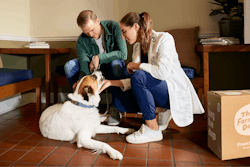
Investors have poured more than US$100 million into direct-to-consumer pet food companies since the start of 2018. Market analysts with investment bank Cascadia Capital reported that data and explored other financial and consumer trends in the report “Pet Industry Overview - Spring 2019.” The Farmer’s Dog raised US$49.1 million in three financing rounds, making the brand the top funded. Ollie dog treats raised the second highest amount with US$17 million. NomNomNow raised US$13 million followed by Just Food for Dogs at US$11.1 million and Pet Plate’s US$6.1 million.
While still a small part of the pet food market, home delivery, make-at-home and other direct-to-consumer pet foods have grown in popularity, echoing similar human food trends. Pet owners increasingly seek fresh ingredients in both their own and their animals’ recipes. Direct-to-consumer pet food companies capitalize on this demand by providing services such as meal kits, customized formulations and automatic refills.
Direct-to-consumer pet foods also help reduce pet owners concerns over supply chain transparency, noted Cascadia analysts.
Concerns for direct-to-consumer pet foods
Despite the recent success, challenges remain for direct-to-consumer pet food companies. The brands are new and unseasoned, so Cascadia’s researchers considered the brands’ lifetime values uncertain. Scaling up the businesses could also be difficult. Production capacity may be limited since the pet foods often require specific ingredients and specialized equipment investments. Distributing the products by mail also raises sustainability concerns over the amount of packaging used compared to retail purchases. Additionally, the average price for direct-to-consumer tends to be high at US$8.50 per day for a 55-pound dog, according to Cascadia’s calculation.
Custom dog food delivery service can’t keep up with demand
An inopportune bowel movement led to the foundation of Farmer’s Dog, an internet-based dog food home delivery service based in New York City, founder Brett Podolsky told Petfood Industry in 2017.
At a dog adoption event, Jada the Rottweiler let loose with a number two, but that didn’t discourage Podolsky from adopting the dog.
“Maybe I should have taken that as a sign, but adopting Jada ended up being the best thing my fiancé ever talked me into,” he said.
Jada was diagnosed with irritable bowel syndrome. After two years of trying to find a dog food that wouldn’t cause a flare-up of Jada’s condition, Podolsky started making his own food for her, following a veterinarian’s advice.
“It was incredible how well and how fast it worked; within a few days her symptoms cleared up,” he said.
Founding of internet-based dog food home delivery service
That led him to found Farmer’s Dog, which focuses on internet-based pet food sales, to share what he had learned and help other pet owners. The main challenge he’s faced is keeping up with demand. Podolsky didn’t want anyone to place an order then be disappointed, so Farmer’s Dog had to use a waiting list to keep customers’ orders from piling up.
“At first, most order came from New York,” he said. “Here, everyone talk to each other. The people who found us were the ones who were really searching, who really needed it. Our original customers were pet parents with dogs suffering from stomach problems and allergies, or that were just very picky eaters. Now our customers are simply anybody that understands the power that food has on our health."
Instead of offering a mind-boggling array of flavor varieties, the website Farmer’s Dog has a questionnaire that allows dog owners to fine-tune a meal option to their canine companions’ needs. Podolsky tries to meet every pet parent’s needs, but there was one order he couldn’t meet.
“A person here in New York wanted a meal for their pot-bellied pig,” he said. “We had to tell them that our foods wouldn’t be appropriate.”
Free dog food recipes served to build trust, attract customers
Once a user selects the customized dog food, it’s prepared, cooked, frozen and shipped to their door within one week. A subscription service keeps track of the pre-portioned dog food and automatically sends a fresh batch when a user needs it.
Another order Podolsky couldn’t fulfill was to a remote forest two-hours from any possible delivery site in rural Hawaii. Although he couldn’t send the dog food, he did send instructions for home-cooking Farmer’s Dog recipes and put the pet owner in contact with a veterinarian to help with nutrition questions. Those instructions are available freely on the Farmer’s Dog website.
Providing recipes shows pet parents that a dog’s health takes precedence over profit for the company, said Podolsky. Giving away the milk doesn’t keep people from buying the cow, in this case though. Many customers, especially those with big dogs, start out making the food at home, then decide it is too much work and start ordering from the Farmer’s Dog home delivery service.
Those convert from home-cooking and many other pet owners have kept Farmer’s Dog growing. That growth isn’t a fluke limited to Podolsky’s business. Pet food ecommerce has grown in recent years, as more consumers want the convenience of home delivery of internet-based pet food sales.
















